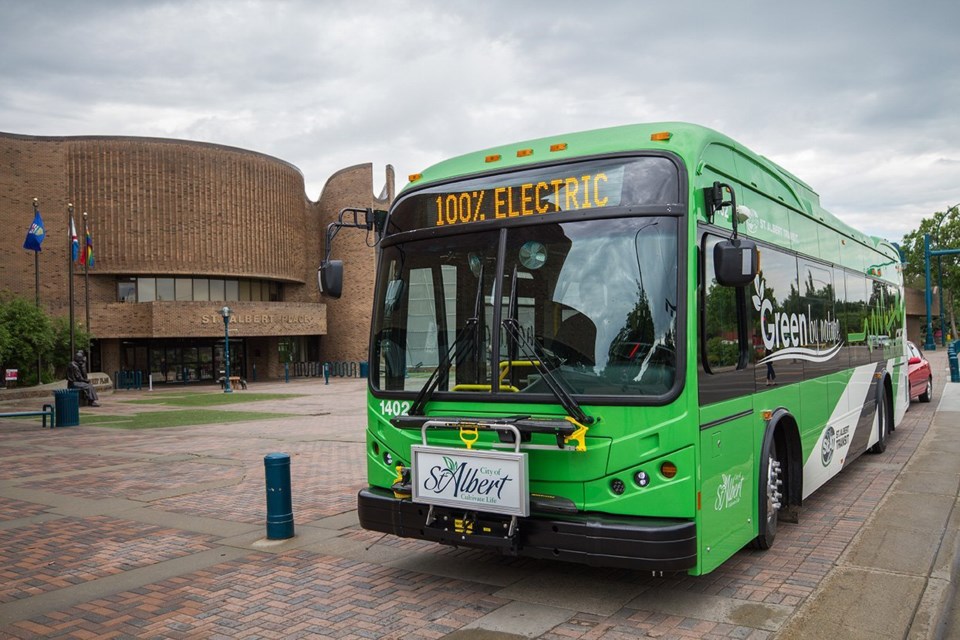Some regular transit riders in St. Albert say incoming changes to bus routes will make transit more difficult for them to access in September.
On Aug. 30, the city's long-awaited Nakî Transit Centre & Park and Ride (formerly Campbell Road Park and Ride) will open to replace the former Village Transit Station.
This required a reconfiguration of some transit routes to accommodate the new station, along with more service hours to meet a slight uptick in demand, according to the city, though ridership numbers have been drastically low due to the COVID-19 pandemic.
Akinsdale resident Bob Gregory, 66, has ridden St. Albert Transit for the last 30 years. He doesn't have a car and relies on public transit to run errands, get to doctors appointments and take his grandchildren to daycare.
With the new station, Gregory said simply going shopping on a Saturday morning would mean he'd have to board a bus to the new station in Edmonton, then transfer to another bus to come back to Village Landing.
"Before, I could get on a bus at 11 a.m. on a Saturday morning and be in Village Landing in five, seven minutes."
Another resident and Special Olympic athlete John Kerby still rides public transit once or twice a week. In a message to the Gazette, he wondered if the city considered input from residents who don't have a car.
Mother of two and Grandin resident Amanda Stark doesn't understand why the city would remove a section of the A1 route her family takes. Instead of the bus taking Granite Avenue to Levasseur Road and into Heritage Lakes, the A31 route goes straight down Grandin Road instead.
That means her children will have to walk about four blocks to the bus stop to get to school – not a fun stroll during winter, she said.
When she reached out to the city, she was told the bus route would be reinstalled once regular service resumes, but it's unknown when that will happen.
"It just doesn't make any sense why they've cut this part of the route out, because we live right close to a daycare and two schools. I just don't get it," Stark said.
Grandin resident Scott Weeteringen has been riding St. Albert Transit for more than nine years and relies on it almost every day. He said he also did not understand why the A1 route was cut from the revised map, and was told by the city it would be put back in place once service levels return to normal.
"They took out my route; completely out – it doesn't come down anymore. So I've got to walk extra blocks to catch a bus ... I can't afford a car," Weeteringen said.
The current weekday modified schedules and Saturday routes and schedules "best reflect the demand due to the reduction in ridership," wrote Ettore Iannacito, St. Albert Transit service delivery manager, in an email to the Gazette.
Speaking to the A1 reroute, "as we are applying Saturday routes on weekdays, Route A31 operates on Grandin Road," Iannacito wrote.
"Passengers can board on Grandin Road with convenient pathway connections to the neighbourhoods impacted, with a slight increase in walking distance, from the alternative bus stops. When regular weekday service can be reinstated, Route A1 service will return to these affected roadways on weekdays."
The route changes result in longer wait times for Weeteringen to get around. Other problems with the city's transit service may leave him without a job, he said – Route 205 takes him to work in the mornings, but that route to West Edmonton Mall is being redirected from 170 St. to 156 St.
Instead, he has to get off on 114 Avenue and walk 45 minutes to 128 St.
"I've got to find a new job because I can't get to work on time. And when it becomes winter, I can't be walking 14 blocks in minus 20-, 30-degree weather to go to work," he said.
All four transit riders who spoke with the Gazette said they believe the city needs to do more public consultation with riders to understand how these changes impact their lives.
"They should have had input from the people (who) actually rely on the bus and take the bus, because we're the ones that need it," Stark said.
"You can call and complain, but they just don't want to listen, and yet we're the ones riding the buses."
Iannacito said transit riders have the ability to voice their concerns by email or by phone. Those comments are then brought up at bi-weekly city meetings, he said.
"That's an opportunity to say, 'Well, you know, we've received these comments from these customers.' If we can react, if it's an easy fix, or if it makes sense, we say let's keep it top of mind and see how we can incorporate that into our future plans or our next opportunity to make changes," Iannacito said.
Every three years, riders are also given a customer satisfaction survey. The last one was done in 2018, said Dustin Creviston, transit operations co-ordinator for the city.
"We would be due to do one in 2021, which takes into account ridership, use of bus stops, customer feedback and various other metrics to analyze how our system is performing," Creviston said.




